

Library > Radiography > Radiography Procedures > Radiography of the Skull, Cranial and Facial Bones, and Paranasal Sinuses
Try Simtics for free
Start my free trialRadiography of the Skull, Cranial and Facial Bones, and Paranasal Sinuses

Materials Included:
-

-

-

-

-

Check our pricing plans here
Unlimited streaming.
The anatomy of the bones of the skull and face is complex, and it is important to understand these structures in order to obtain optimal radiographic projections. This SIMTICS module teaches you how to prepare for, set up, and obtain radiographs of the skull, cranial and facial bones, and paranasal sinuses. Including both practice and test modes, the online simulator features three different patient scenarios. This module offers students and practitioners the knowledge, cognitive skills and a safe practice environment to perform these procedures accurately, in preparation for working in a clinical setting. If you are studying for the American Registry of Radiologic Technologists® (ARRT) registry exams, this module is ideal.
You’ll learn
- to practice, perfect, and test your skills in obtaining X-rays of the skull, cranial and facial bones, and paranasal sinuses
- to better visualize and understand the anatomy of the head – especially the skull, cranial and facial bones, and paranasal sinuses - with our 3D anatomical model
- to identify the indications and contraindications for obtaining radiographic projections of the skull, cranial and facial bones, and paranasal sinuses
- how to manage the requirements of trauma and pediatric patients
- how to position a patient to obtain optimal images of the skull, cranial and facial bones, and paranasal sinuses
- much more (see “content details” for more specific information)
- Describe indications for radiographic procedures of the skull, cranial and facial bones, and paranasal sinuses
- Describe and utilize radiographic positioning terminology
- Discuss anatomical details of the skull, cranial and facial bones, and paranasal sinuses
- Discuss skull, cranial and facial bones, and paranasal sinuses protocols
- Describe positioning criteria and anatomical landmarks for each skull, cranial and facial bones, and paranasal sinuses projection
- Discuss the radiographic requirements for skull, cranial and facial bones, and paranasal sinuses with regards to trauma and pediatric patients
- Analyze the radiographs for quality and correct positioning criteria
- Discuss skull, cranial and facial bones, and paranasal sinuses pathologies
- Explain the Patient's Bill of Rights, HIPAA Privacy Rule, and Patient Safety Act (see reference)
The SIMTICS modules are all easy to use and web-based. This means they are available at any time as long as the learner has an internet connection. No special hardware or other equipment is required, other than a computer mouse for use in the simulations. Each of the SIMTICS modules covers one specific procedure or topic in detail. Each module contains:
- an online simulation (available in Learn and Test modes)
- descriptive text, which explains exactly how to perform that particular procedure including key terms and hyperlinks to references
- 2D images and a 3D model of applied anatomy for that particular topic
- a step by step video demonstration by an expert
- a quiz
- a personal logbook that keeps track of all the modules the learner has studied and how long
For more details on features and how your students can benefit from our unique system, click here.





